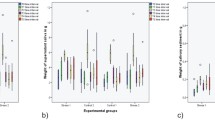Abstract
The usefulness of individual salivary protein spectra as indicators of resistance to stress is discussed. Analyses of total saliva performed before and after exposure to model stress showed that individual psychological and autonomic reactions correlated with specific changes in the concentrations of certain salivary proteins. Therefore, such an analysis could be useful for the assessment of individual resistance to stress.
Similar content being viewed by others
References
Lac, G., Saliva Assays in Clinical and Research Biology, Pathol. Biol., (Paris) 2001, vol. 49, no. 8, p. 660.
Tabak, L.A., A Revolution in Biomedical Assessment: The Development of Salivary Diagnostics, Dent. Educ., 2001, vol. 65, no. 12, p. 1335.
Seifert, G., Salivary Glands and the Organism-Interrelations and Correlating Reactions, Laryngorhinootologie, 1997, vol. 76, no. 6, p. 387.
Grigor’ev, I.V., Ulanova, E.A., and Ladik, B.B., Protein Composition of the Total Saliva of Patients with Depressive Syndrome, Klin. Labor. Diagn., 2002, no. 1, p. 15.
Grigor’ev, I.V., Nikolaeva, L.V., and Artamonov, I.D., Saliva Protein Composition of Subjects in Different Mental and Emotional States, Biokhimiya, 2003, vol. 68, no. 4, p. 501.
Grigor’ev, I.V., Ulanova, E.A., Artamonov, I.D., and Bogdanov, A.S., Protein Composition of the Total Human Saliva: Mechanisms of Psychophysiological Regulation, Vestn. Ross. Akad. Med. Nauk, 2004, no. 7, p. 36.
Doyle, A., Hucklebridge, F., Evans, P., and Clow, A., Salivary Monoamine Oxidase A and B Inhibitory Activities Correlate with Stress, Life Sci., 1996, vol. 59, no. 16, p. 1357.
Smith-Hanrahan, C., Salivary Kallikrein Output during the Stress Response to Surgery, Can. J. Physiol. Pharmacol., 1997, vol. 75, no. 4, p. 301.
Okumura, T., Nakajima, Y., Matsuoka, M., et al., Study of Salivary Catecholamines Using Fully Automated Column-Switching High-Performance Liquid Chromatography, J. Chromatogr. Biomed. Appl., 1997, vol. 694, no. 2, p. 305.
Lukash, A.I., Zaika, V.G., Milyutina, N.P., and Kucherenko, A.O., The Rates of Free-Radical Reactions and the Activity of Antioxidant Enzymes in Saliva and Plasma of Emotionally Stressed Subjects, Vopr. Med. Khim., 1999, vol. 45, no. 6, p. 503.
Stephen, B.P., Quantitative Aspects of Stress-Induced Immunomodulation, Int. Immunopharmacol., 2001, vol. 1, no. 3, p. 507.
Yudin, B.G., Principles of Bioethics, in Bioetika: printsipy, pravila, problemy (Bioethics: Principles, Regulations, and Problems), Moscow: Editorial URSS, 1998, p. 5.
Leonova, A.B., Psikhodiagnostika funktsional’nykh sostoyanii cheloveka (Psychodiagnostics of Human Functional States), Moscow, 1984.
Mikhailov, V.M., Variabel’nost’ ritma serdtsa (Heart Rhythm Variability), Ivanovo, 2000.
Heart Rate Variability. Standards of Measurements, Physiological Interpretation, and Clinical Use. Task Force of the European Society of Cardiology and the North American Society of Pacing and Electrophysiology, Circulation, 1996, vol. 87, p. 1043.
Baevskii, R.M., Ivanov, G.G., and Ryabykina, G.V., Current State of the Studies of the Heart Rhythm Variability in Russia, Vestn. Aritmol., 1999, no. 14, p. 71.
Leonova, A.B. and Kapitsa, M.S., Methods of the Subjective Assessment of Human Functional States, in Strelkov, Yu.K., Ed., Praktikum po inzhenernoi psikhologii i ergonomike (Handbook of Engineering Psychology and Ergonomics), Moscow, 2003.
Leonova, A.B., A General Strategy Used to Analyze Occupational Stress: From Diagnosis to Prevention and Correction, Psikhol. Zh., 2004, vol. 5, no. 2, p. 75.
Laemmli, U.K., Cleavage of Structural Proteins during the Assembly of the Head of Bacteriophage T4, Nature, 1970, vol. 227, p. 680.
Author information
Authors and Affiliations
Additional information
Original Russian Text © I.V. Grigor’ev, I.D. Artamonov, V.V. Lapkovskii, O.S. Glazachev, E.N. Dudnik, A.B. Leonova, 2006, published in Fiziologiya Cheloveka, 2006, Vol. 32, No. 6, pp. 87–94.
Rights and permissions
About this article
Cite this article
Grigor’ev, I.V., Artamonov, I.D., Lapkovskii, V.V. et al. Changes in the protein composition of human saliva associated with model psychological and emotional stress. Hum Physiol 32, 707–713 (2006). https://doi.org/10.1134/S0362119706060144
Received:
Issue Date:
DOI: https://doi.org/10.1134/S0362119706060144



